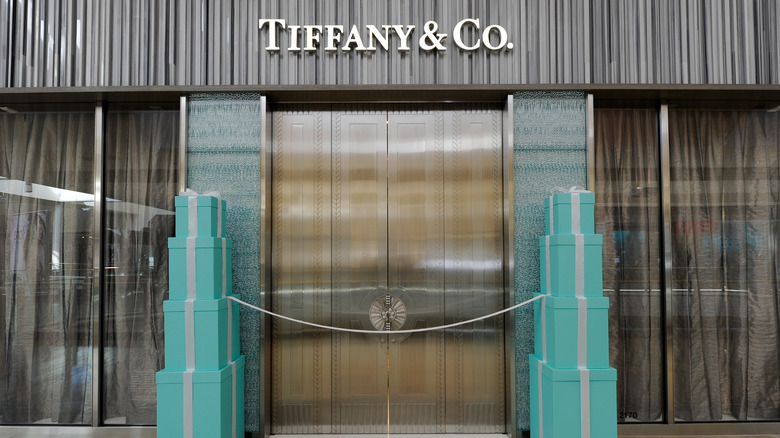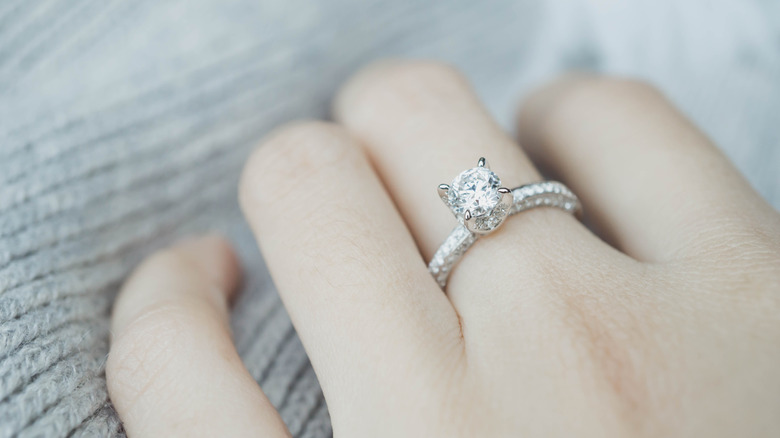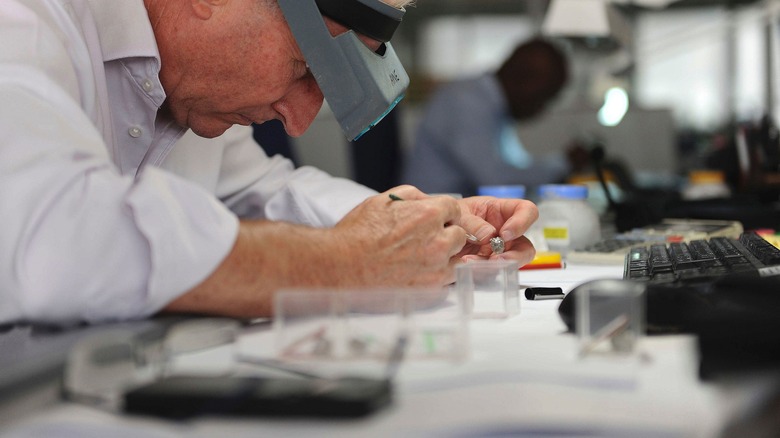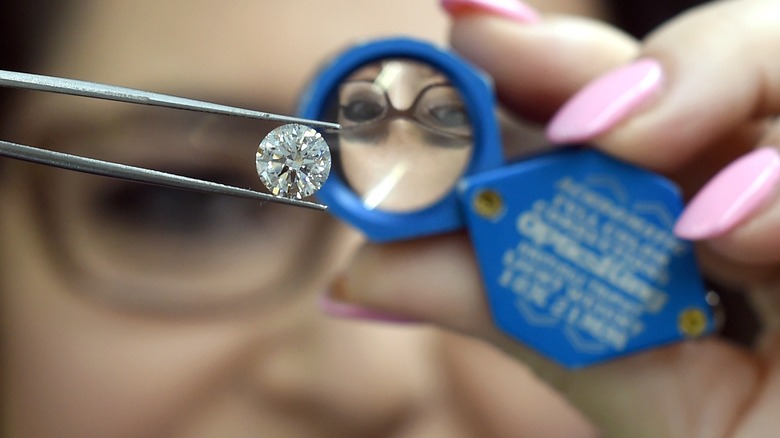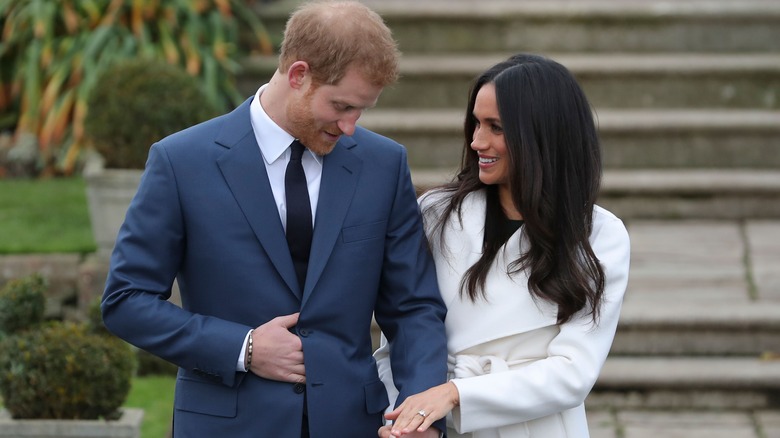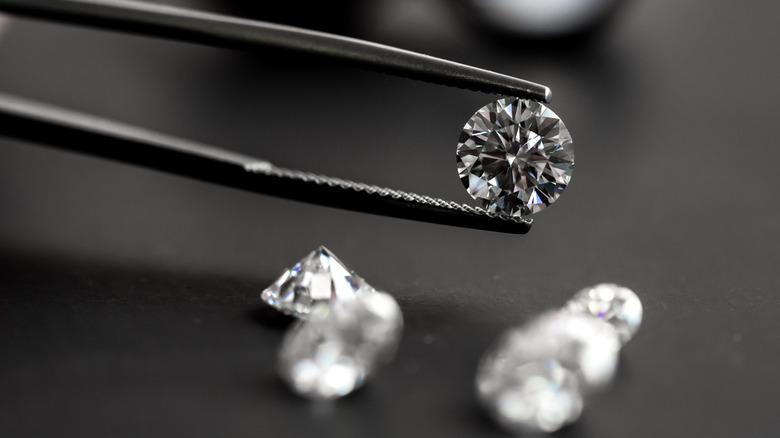The Real Reason Why Your Diamonds Aren't Valuable
What's the first thing you do, or want to do, when someone gets engaged? Whether the person in question is your close friend, acquaintance, or even a celebrity, you just have to ogle the ring, right? Specifically, that rock.
Experts agree that any diamond above two or three carats is "big." So then, the bigger the diamond, the more valuable the ring — right? Actually, no. Here's the real reason why diamonds — of any size — aren't as valuable as you may think.
They're definitely not rare
When's the last time you saw an engagement ring that didn't feature a diamond? It's probably been a while, if ever at all. According to The International Gem Society (IGS), the diamond is the most popular gemstone. Nonetheless, a myth about the gem continues to be believed: Diamonds are rare.
Well, all "gem-quality materials" are technically rare because they're natural materials with limited quantities Earth. That said, diamonds are one of the least rare among gemstones. It's so common that, as of 1982, over 100 million women were wearing diamonds in some fashion, and millions of additional women packed them away in safe-deposit boxes, The Atlantic reported. It was also estimated that the public held 500 million carats of diamonds, possibly more, by that time.
Shockingly, this was all before the Argyle mine in Western Australia even came into the picture. In operation since 1983, the mine has produced over 800 million carats of diamonds and is the largest diamond supplier in the entire world.
Diamonds are the opposite of rare.
They've been marked up
Not only are diamonds common, but we're also paying way more for them than they're worth. Sure, diamonds go through a very involved process. But, still, the markup is outrageous. Longtime jeweler, Vincent Taylor, told The Guardian, "Profit margins [by high-end jewelers] are so big that the price you pay is a false price." Although Taylor is located in the United Kingdom, similar markups exist in the United States.
According to The Atlantic, the markup on a diamond, along with its setting, could be anywhere between 100 and 200 percent. In a removed video reported on by Uproxx, a YouTuber by the name of Jason investigated diamond prices and discovered the staggering markups for himself — from 253 percent at Tiffany & Co. to 336 percent at Harry Winston.
Costco swooped in on this lucrative market, and started selling Tiffany-esque rings for a more reasonable price — their error was using the word "Tiffany" to help describe and sell the product. Obviously, that did not sit well with Tiffany & Co. who, as reported by CNBC, sued the company in 2013 for $19.4 million. When it comes to diamonds, it seems the customer never wins.
They're a terrible investment
Are diamonds a good investment? Not according to experts. "A diamond ring is not an investment in the sense of making a return on your money because you will never get what you put in it back out," financial planner, Christopher Cannon, told The Cheat Sheet. Another expert and financial planner, Ed Snyder, explained, "Retailers mark [diamond rings] up so high, they depreciate as soon as you walk out of the store."
Many customers would concur. After discovering her husband was having an affair, a woman divorced him and attempted to recoup some of the money from her engagement ring. Although it originally cost £1,000 (nearly $1,225 USD), a jeweler offered her £50 ($70) after haggling. "I even had a certificate that verified the diamond's authenticity," she told The Guardian. Yikes! Of course, the situation is similar in America. Personal finance expert, David Bakke, estimated a slightly higher return to The Cheat Sheet, but still thinks you could only get back 60% of what you paid.
Much like a car that depreciates as soon as you drive it off the lot, diamond rings don't hold on to their value.
A diamond is (not) forever
In the late 1940s, a copywriter for advertising agency N. W. Ayer came up with a caption for De Beers, their client, that you're probably still familiar with today: "A Diamond Is Forever." According to The Atlantic, his caption was then plastered beneath a picture of a honeymooning young couple. It's true that diamonds can physically stand the test of time as they are the hardest gemstone, but are they really everlasting?
Not quite. Despite their hardness, diamonds can become discolored, chip, and even shatter. Naturally, that information wouldn't make it into the ad. In just one year's time, "A Diamond Is Forever" became the official slogan of De Beers, the most powerful diamond cartel at that time. This was all part of the plan to dupe Americans into buying diamonds as opposed to other gems. An excerpt from N. W. Ayer's strategy plan (via The Atlantic) described how they wanted to "strengthen the tradition of the diamond engagement ring" and make it a "psychological necessity." They set out to conflate diamonds with romance. Did they succeed?
In the 1940s, young men bought about 90% of the engagement rings on the market. De Beers knew they needed to make those men believe that diamonds were a "gift of love." The bigger the diamond, the greater act of love. They also realized they had to convince women that diamonds were an "integral part" of their relationships. Diamond sales shortly went up by 55 percent — boom. How's that for inception?
Diamonds are a man's best friend
Before the "Diamonds are forever" concept came to be, another factor contributed to the success of diamond rings. According to Slate, until the 1930s, if a man left his bride at the alter (or at any point during their engagement), she could sue him for damaging her reputation under the "Breach of Promise" act. Woo-hoo, women's rights! Unfortunately, that law was short-lived. De Beers capitalized on the situation and swooped in with their diamond rings, which quickly became the ideal way for men to show a "symbol of financial commitment" to their fiancées.
It may sound all well and good, but the engagement ring's purpose is a bit icky. The "Breach of Promise" protected women from "seduce-and-abandon scenarios," e.g. losing their virginity to their fiancee and being subsequently dumped. Since the engagement ring replaced the "Breach of Promise" act, a woman's virginity was more or less equal to the price of a diamond engagement ring. That is no longer the case today, but the engagement ring does still serve as a "hands-off" symbol of sorts — one most women, subconsciously or consciously, abide by today.
The Monopoly Man
There's a good reason you're seeing De Beers come up so often in this article. According to IGS, the company sustained control over diamond production and sales for decades. As a monopoly, they had the power to do some pretty shady things, like releasing just enough diamonds to meet the demand and carefully and continually adjusting just how many rough diamonds were available at any given time. It also allowed them to inflate prices and create a false sense of rarity around the precious stones.
According to Bloomberg, the corporation was incredibly successful and massively powerful until the early 2000s, when the diamond king found itself dethroned. Nevertheless, De Beers is still active in the diamond industry. In 2017, they invested $140 million into their marketing budget. While the diamond market is performing worse than in years past, De Beers excels in high-stress situations. After all, the company got off the ground during an economic downturn and saw success from the Great Depression onward. "No pressure, no diamonds," right? De Beers just might be forever.
Lab-grown diamonds
Although mining for diamonds will likely last as long as it can be sustained, there are other ways to source diamonds. According to Business Insider, lab-grown diamonds, or synthetic diamonds, are increasingly popular, even though they've been around since as early as the 1950s. Synthetic diamonds also cost between 15 and 30 percent less than real ones. Though, knowing how much natural diamond prices are inflated, 15 percent off doesn't sound like much. The process is a doozy — arguably more involved than mining — so the high price makes sense. It also makes sense that, with the influx of diamond alternatives, mining companies would need to up their marketing game to remain in the public eye.
In a comprehensive collection of advertisements called "Real is Rare," the Diamond Producers Association (DPA) strives to do just that. According to survey results by the DPA, diamond producers don't seem too worried about synthetic diamond sales. After surveying a thousand millennial women, they found 89 percent looked for authenticity when purchasing luxury items, like diamonds. The DPA also discovered 94 percent of the highest earning millennial women surveyed would rather buy one authentic expensive item over many cheaper ones. Unfortunately, a drop in diamond prices — real or synthetic — seems unlikely.
The elite are still wearing them
Even if the lab-grown diamond market goes on to experience an incredible surge in sales, it's hard to imagine that real diamonds would ever disappear, especially if celebrities keep wearing them. The most spectacular rings worn by celebrities tend to include real diamonds, after all.
Meghan Markle's ring was recently on everyone's minds and browser histories. And, who could forget Mariah Carey's ginormous 35 carat engagement ring from James Packer? It's not just women sporting these ostentatious rocks, either. In 2016, Darren Rovell confirmed on Twitter, "There are 283 diamonds in [the New England Patriots'] new champ ring." Yes, 283 — in one ring.
With the rich and famous constantly donning diamonds, the rocks practically sell themselves.
The future worth of diamonds
One day, diamonds may actually be valuable in the real sense of the word. There will, eventually, be fewer new diamonds coming from the mines, according to The Economist. An analyst for De Beers, Des Kilalea, cited, "The best and easiest deposits are already found." The Economist also speculated that, while a supply of new diamonds is expected to peak, it will be followed by a slow and steady decline. One of the mines De Beers uses will close by the year 2030, having had all its diamonds unearthed.
While it's impossible to say with any certainty what the future holds, there may come a day when diamonds are truly rare and extremely valuable.



